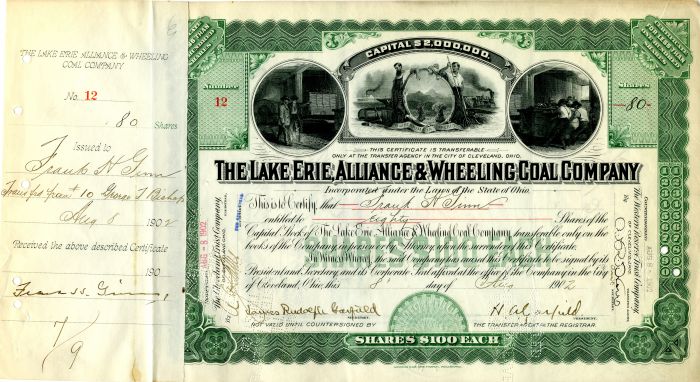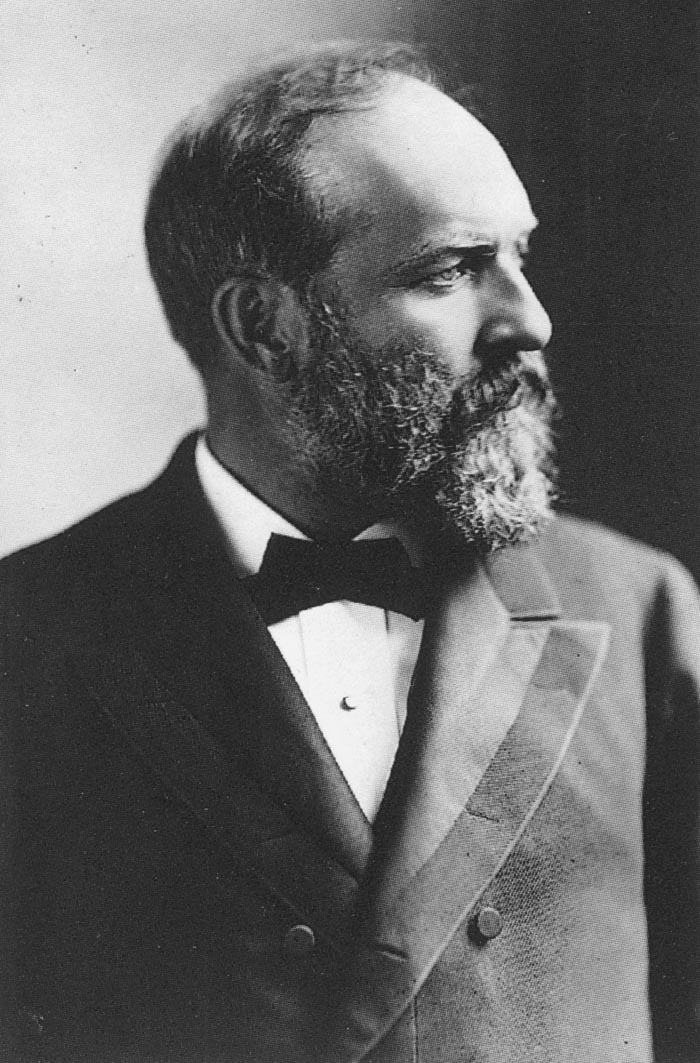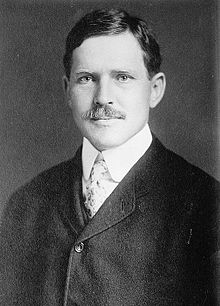Lake Erie, Alliance and Wheeling Coal Co. signed by James R. Garfield and H.A. Garfield - Stock Certificate
Inv# AG1298A Stock

James Abram Garfield (1831-1881) was the 20th President of the United States, serving from March 4, 1881 until his death on September 19, 1881, a brief 200 days in office. He had the second shortest presidential tenure after William Henry Harrison. He was also the only incumbent of the U.S. House of Representatives to be elected President.
Garfield was born in Moreland Hills, Ohio and graduated from Williams College, Massachusetts in 1856. He married Lucretia Rudolph in 1858. They had seven children (five sons and two daughters). After preaching a short time at Franklin Circle Christian Church (1857–58), Garfield ruled out preaching and considered a job as principal of a high school in Poestenkill, New York. After losing that job to another applicant, he taught at the Eclectic Institute. Garfield was an instructor in classical languages for the 1856–1857 academic year, and was made principal of the Institute from 1857 to 1860. In 1860, he was admitted to the Bar whilst serving as an Ohio State Senator (1859–1861).
Garfield served as a major general in the United States Army during the American Civil War and fought at the Battle of Shiloh. He then served under Thomas J. Wood in the subsequent Siege of Corinth. His health deteriorated and he was inactive until autumn, when he served on the commission investigating the conduct of Fitz John Porter. In the spring of 1863, Garfield returned to the field as Chief of Staff for William S. Rosecrans, commander of the Army of the Cumberland.
In October 1862, while serving in the field, he was elected by the Republicans to the United States House of Representatives for Ohio's 19th Congressional District in the 38th Congress. As Congress did not meet until December 1863, Garfield continued to serve with the army and was promoted to major general after the Battle of Chickamauga. He resigned his commission, effective December 5, 1863, to take his seat in Congress. He was re-elected every two years, from 1864 through 1878, during the Civil War and the following Reconstruction era. He was one of the most hawkish Republicans in the House.
Following compromises with Ulysses S. Grant, James G. Blaine and John Sherman, Garfield became the Republican party nominee for the 1880 Presidential Election and successfully defeated Democrat Winfield Hancock.
Because he spent so little time as President, Garfield accomplished very little. In his inaugural address, Garfield outlined a desire for Civil Service Reform which was eventually passed by his successor Chester A. Arthur in 1883 as the Pendleton Civil Service Reform Act. His presidency was cut short after he was shot by Charles J. Guiteau while entering a railroad station in Washington D.C. on July 2, 1881. He was the second United States President to be assassinated. Following his death, Garfield was succeeded by Vice-President Chester A. Arthur.

James Rudolph Garfield (October 17, 1865 – March 24, 1950) was an American politician and lawyer. Garfield was a son of President James A. Garfield and First Lady Lucretia Garfield. Garfield was born in Hiram, Ohio, the third of seven children born to James Abram and Lucretia Rudolph Garfield. For a year prior to his father's presidency, he studied at St. Paul's School in Concord, New Hampshire. On July 2, 1881, at the age of 15, he and his 17-year-old brother, Harry Augustus Garfield, witnessed the shooting of their father by disgruntled office-seeker Charles J. Guiteau at the Baltimore and Potomac railroad station in Washington. The President and his sons were waiting for a train en route to Williams College in Williamstown, Massachusetts, where young James had been recently accepted, when the shooting took place. Following his father's death on September 19, 1881, he studied at Williams College. He received his A.B. degree in 1885, and then attended Columbia Law School. In 1888, he was admitted to the Ohio bar and established the Cleveland, Ohio-based law firm of Garfield and Garfield, with his brother Harry Augustus Garfield. From 1890 until her death in 1930, he was married to Helen Newell. They had four sons, John, James, Newell, and Rudolph. Their grandson, Newell Garfield, later married Jane Harrison Walker, a granddaughter of President Benjamin Harrison and Harrison's second wife, Mary Dimmick Harrison, as well as the great-grandniece of James G. Blaine. From 1896 to 1899, he served in the Ohio State Senate. He was an influential advisor to President Theodore Roosevelt, serving as a Member of the United States Civil Service Commission from 1902 to 1903. From 1903 to 1907, he served as Commissioner of Corporations at the Department of Commerce and Labor, where he conducted investigations of the meat-packing, petroleum, steel, and railroad industries. From 1907 to 1909, he served in Roosevelt's Cabinet as Secretary of the Interior, where he advocated for the conservation of natural resources. He left this post on March 4, 1909, and returned to his law practice in Cleveland. In 1909, he received an honorary LL.D. degree from the University of Pittsburgh. Garfield was a contender for the Ohio Republican gubernatorial nomination in the 1910 election but withdrew from the convention when it endorsed the Taft Administration; the convention went on to nominate future president Warren G. Harding in the third round of balloting. During the 1912 presidential election, he was a key supporter of Roosevelt's bid for a third term. In the 1914 election, he made an unsuccessful bid for Governor of Ohio on the Progressive Party ticket.
A stock certificate is issued by businesses, usually companies. A stock is part of the permanent finance of a business. Normally, they are never repaid, and the investor can recover his/her money only by selling to another investor. Most stocks, or also called shares, earn dividends, at the business's discretion, depending on how well it has traded. A stockholder or shareholder is a part-owner of the business that issued the stock certificates.









Ebay ID: labarre_galleries